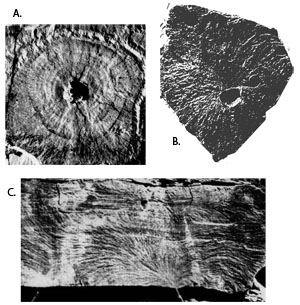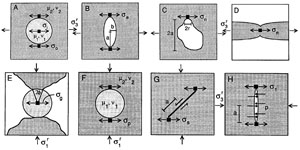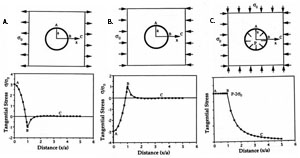| |||||||
|
|
|||||||
|
|
|||||||
| Initiation of Joints | |||||||
|
Joints, similar to other discontinuities such as faults and pressure solution seams, initiate at flaws including inclusions, crystal defects, grain contacts, cavity and pores, fossils, sole marks, and cusps (Figure 1). Joints initiate at flaws because flaws with different elastic properties than the surrounding rock perturb the stress field. There are two circumstances that are important and we discuss these in the next two paragraphs. Flaws can amplify tensile stress. The concentration of local stress at flaws may drive the initiation and propagation of a joint under a remote stress insufficient by itself to cause jointing. For stiff inclusions, a remote tensile stress can be amplified by a factor up to 1.5 inside the inclusion. For soft circular inclusions or cavities, stress at the surrounding rock around the inclusion is amplified. For example, for a spherical cavity with a circular section, this amplification is equal to a factor of 3 (Figure 2A; Figure 3A, point A). For an elliptical cavity, the amplification factor depends on the shape or sharpness of the inclusion or cavity instead of its size; the larger the axial ratio, a over b in Figure 2B and r over a in 2C, the larger the maximum amplification factor. The local maximum tensile stress occurs where the radius of curvature is the smallest. For a long and thin cavity, the magnitude of the stress at the tip can be many times that of the applied remote stress. Stress concentration allows us to make important inferences. For two flaws with unequal lengths subjected to the same increasing driving stress, the longer or slimmer one will meet the propagation criterion first. Flaws can also induce local tensile stresses in an overall compressive environment. Figure 2E shows a grain at diametrical contact with two other grains, which results in tensile stress under an applied compressive stress. Figure 2F and Figure 3B (point B) show a cavity inducing tension of the same magnitude at two points at the cavity border. Figure 2G shows shearing induced tensile stress at the tip region of the sliding plane under compressive stress. Figure 2H and Figure 3C show a common mechanism of joint initiation based on cavities or micro-cracks subjected to internal fluid pressure. Pore fluid pressure amplifies the stresses at the flaw tip in Figure 2H and neutralizes the hydrostatic pressure in Figure 3C. | |||||||
| Reference: |
|||||||
| Aydin, A., 1996 Pollard, D.D., Aydin, A., 1988 Pollard, D.D., Fletcher, R.C., 2005 |
|||||||
|
Readme | About Us | Acknowledgement | How to Cite | Terms of Use | Ⓒ Rock Fracture Knowledgebase |
|||||||


